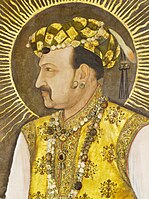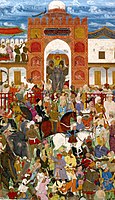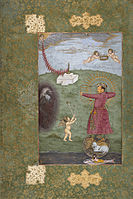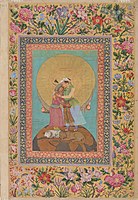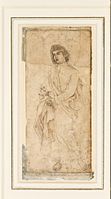Abu'l-Hasan (artist)
Abu'l-Hasan | |
|---|---|
 Portrait of Abu al-Hasan by Daulat from the Gulshan Album (c. 1610) | |
| Style | Mughal |
| Patron(s) | Jahangir |
Abu'l-Hasan (or Abu al-Hasan; 1589 – c. 1630), from Delhi, India, was a Mughal painter of miniatures during the reign of Jahangir.
Biography
[edit]
Abu al-Hasan was the son of Aqa Reza Heravi of Herat in Safavid Iran, a city with an artistic tradition. Aqa Reza was established as an artist and took up employment with Jahangir (r. 1605 –1627) before the latter's accession to the throne of the Mughal empire.[1] When Abu al-Hasan began producing art, the emperor, Jahangir, appreciated the skills of the boy.[2] In 1599, Abu al-Hasan moved with Jahangir to his newly founded court in Allahabad.[3]
The emperor considered Abu al-Hasan to be particularly special to him and under his care.[1] This is because although Abu al-Hasan's artwork was similar in many ways to his father's with Dutch and English influence, it was considered to be of a higher quality similar to that of older masters in the field.[1][2] Jahangir said of Abu al-Hasan that he had no equal and for the work done on the frontispiece for his memoires, the emperor bestowed the title Nadir-uz-Saman ("Wonder of the Age") on Abu al-Hasan in 1618.[4]
Abu al-Hasan's main task was the documentation of events at the imperial court, which resulted in many portraits being completed. Portraits were the hallmark of Jahangir's rule.[5] Not many of Abu al-Hasan's paintings survived, but those that identify him as the artist show that he also worked on a range of subjects, including some everyday scenes[6] and political paintings that showed the emperor and Mughal empire in a positive and powerful light.[7] In addition to original works of art, Abu al-Hasan also retouched other artists' paintings (one such example is below: Dancing Dervishes)[1]
Abu al-Hasan's career aligned with developments in the style of Mughal paintings.[1] However, when Jahangir's reign came to an end, and Shah Jahan began his rule, Abu al-Hasan's career became less active until 1628 from which point on, there is no evidence of him producing art.[4]
Works
[edit]| Title | Year | Current location | Notes | Material |
|---|---|---|---|---|
| Study of Saint John the Evangelist, After Albrecht Dürer | c. 1600 –1601 | Metropolitan Museum of Art | Completed by the artist at the age of 13, this is considered an accurate study of Albrecht Durer's (a German artist) original.[4] | Brush drawn ink on paper |
| Spotted Forktail | c. 1610 –1615 | Metropolitan Museum of Art | Portrays a spotted forktail bird, usually found in the Himalayas, caught in a hunt[1][8] in Jangespur (which is not a known location today) that the emperor demanded be drawn. The gilding along the border decorated with floral motifs, however, was not completed by Abu al-Hasan, but another artist named as Harif by an inscription.[1] Folio from the Shah Jahan Album | Ink, opaque watercolor, and gold on silk |
| Jahangir Shoots Malik 'Anbar | c. 1620 | Freer Gallery of Art | Opaque watercolor, ink and gold on paper | |
| Emperor Jahangir Triumphing over Poverty | c. 1620 –1625 | Los Angeles County Museum of Art | Opaque watercolor, gold, and ink on paper | |
| Darbar Scene of Jahangir | c. 1615 | Freer Gallery of Art | Abu al-Hasan doesn't label the globe, but puts it under Emperor Jahangir's feet and gives the emperor a key to the globe. The inscription reads, "The key of victory over the two worlds is entrusted in his hand".[7] | Opaque watercolor, ink and gold on paper |
| Allegorical Representation of Emperor Jahangir and Shah 'Abbas of Persia | c. 1618 | Freer Gallery of Art | This political painting was inspired, according to Abu al-Hasan, by a dream. It depicts Jahangir and Abbas in a situation in which Mughal emperor, Jahangir, is in a more powerful position, standing on a lion, embracing the shorter Shah Abbas of Iran (his cousin) who is standing on a small lamb and cannot fully reach around Jahangir's body. In reality the two were enemies vying over territory in Afghanistan and this scene did not actually occur.[9][7] | Opaque watercolor, ink, silver and gold on paper |
| The Mughal Emperor Jahangir with Radiant Gold Halo, Holding a Globe | c. 1617 | Sotheby's Picture Library, London | Cartographic artifacts, such as the globe in this painting, were regarded as distinguished and could increase the reputation of the owner or holder of such an object. It was as much a symbol of royalty as a crown. This artwork was painted in Mandu. The Persian verses espouse the emperor's greatness in the context of other world empires. In this painting, the globe isn't labeled.[7] This painting's image measures 197 x 128.5 cm and is the largest known Mughal painting. | Gouache with gold on fine cotton |
| Squirrels in a Plane Tree | c. 1610 | British Library | One of the most famous painting associated with Abu al-Hasan's name, Squirrels in a Plane Tree, is a depiction of animal posture and movement. The painting depicts European squirrels unknown in India. The signature on the painting is unclear: Nadir al-Asr ("Miracle of the Age") is the title of Ustad Mansur, not of Abu al-Hasan, but the painting is not in Ustad Mansur's style. It is possible that both painters collaborated on this painting.[6] | Gouache on Paper |
| Jahangir entertains Abbas | c. 1620 | Freer Gallery of Art | Although the scene depicted in this painting never took place, it shows the reception of the Safavid Shah 'Abbas I by the Mughal emperor. Within the painting are many objects and people used to elevate the Mughal court and Emperor Jahangir, such as international imagery and status symbols. One example is the Diana Automaton.[10] This painting became a part of the St. Petersburg album when it, and many other Mughal artworks, were seized by Nader Shah in 1739.[11] | Opaque watercolor, gold and ink on paper |
| Jahangir as the Queller of Rebellion | c. 1623 | Jahangir with a halo around his head, holds a globe with a royal seal on it while dressed in a Mughal outfit. The painting portrays the emperor after he successfully put an end to a rebellion led by one of his sons, Prince Shah Jahan.[1] Was in an exhibition held at the Metropolitan Museum, October 21, 1987-February 14, 1988. | ||
| Dancing Dervishes | c. 1610 | This painting is attributed to Aqa-Miraq (mid-sixteenth century) but was painted over, most likely, by Abu al-Hasan (c. 1610). It portrays a Mevlevi Sema' Ceremony, an event filled with music, dance, and ritual.[1] Was in an exhibition held at the Metropolitan Museum, October 21, 1987-February 14, 1988 | Ink, opaque watercolor, and gold on paper |
Gallery
[edit]-
Squirrels in a Plane Tree (c. 1610).
-
Portrait of Jahangir (detail) by Abu al-Hasan, 1617.
-
Saʿdī presents a book of his poems, 1615, Walters Art Museum.
-
Portrait of Jahangir, 1615–1620, Metropolitan Museum of Art.
-
Spotted Forktail, Folio from the Shah Jahan Album, c. 1610–1615, Metropolitan Museum.
-
Celebrations at the accession of Jahangir. Jahangirnama. St. Petersburg Album, c. 1615–1618, Institute of Oriental Manuscripts of the Russian Academy of Sciences.
-
Emperor Jahangir Triumphing over Poverty, attributed to Abu'l Hasan, c. 1620–1625. Opaque watercolor, gold, and ink on page, 23.81 x 15.24 cm.
-
Durbar Scene of Jahangir. Painted by Abu'l Hasan, ca. 1615. Opaque water color, gold, and ink on paper, 16.9 x 12.3 cm. Freer Gallery of Art, Smithsonian Institution, Washington, D.C., purchase F1946.28.
-
Abu'l - The St. Petersburg Album - Allegorical representation of Emperor Jahangir and Shah.
-
Abu'l Hasan, Jahangir Entertains Shah Abbas, c. 1620. Washington, DC: Freer and Sackler Galleries.
-
The Mughal Emperor Jahangir with Radiant Gold Halo, Holding a Globe (c. 1617). The largest known Mughal portrait depicting Emperor Jahangir. Attributed to Abu'l Hasan, Nadir al-Zaman painted at Mandu.
-
Abu'l Hasan. Study of St. John Evangelist adapted from Durer's Crucifixion engraving of 1511. Dated 1600 –1601, The Ashmolean Museum, Oxford.
-
"Dancing Dervishes", Folio from the Shah Jahan Album. Originally by Aqa Mirak, retouched by Abu'l Hasan.
References
[edit]- ^ a b c d e f g h i Welch, Stuart Cary; Schimmel, Annemarie; Swietochowski, Marie L.; Thackston, Wheeler M. (1987). The Emperors' album: images of Mughal India. New York: The Metropolitan Museum of Art. OCLC 893699157. Archived from the original on 1 August 2018. Retrieved 7 June 2021.
- ^ a b Beach, Milo Cleveland (24 September 1992). Mughal and Rajput Painting. Cambridge University Press. doi:10.1017/chol9780521400275. ISBN 978-0-521-40027-5. Archived from the original on 15 March 2024. Retrieved 13 May 2021.
- ^ "1600–1660: Mughal painting and the rise of local workshops", Mughal and Rajput Painting, The New Cambridge History of India, Cambridge University Press, pp. 68–156, 24 September 1992, doi:10.1017/chol9780521400275.006, ISBN 978-0-521-40027-5, archived from the original on 15 March 2024, retrieved 13 May 2021
- ^ a b c "Study of Saint John the Evangelist, After Albrecht Dürer". www.metmuseum.org. Archived from the original on 21 May 2021. Retrieved 21 May 2021.
- ^ "1600–1660: Mughal painting and the rise of local workshops", Mughal and Rajput Painting, The New Cambridge History of India, Cambridge University Press, pp. 68–156, 24 September 1992, doi:10.1017/chol9780521400275.006, ISBN 978-0-521-40027-5, archived from the original on 15 March 2024, retrieved 13 May 2021
- ^ a b Potter, Polyxeni (September 2009). "Never Has There Been a Shade1". Emerging Infectious Diseases. 15 (9): 1541–1542. doi:10.3201/eid1509.000000. ISSN 1080-6040. PMC 2819890.
- ^ a b c d Ramaswamy, Sumathi (October 2007). "Conceit of the Globe in Mughal Visual Practice". Comparative Studies in Society and History. 49 (4): 751–782. doi:10.1017/s0010417507000758. ISSN 0010-4175. S2CID 144619248. Archived from the original on 15 March 2024. Retrieved 13 May 2021.
- ^ ""Spotted Forktail", Folio from the Shah Jahan Album". www.metmuseum.org. Archived from the original on 23 November 2016. Retrieved 21 May 2021.
- ^ "Allegorical representation of Emperor Jahangir and Shah Abbas of Persia from the St. Petersburg Album". Freer Gallery of Art & Arthur M. Sackler Gallery. Archived from the original on 13 May 2021. Retrieved 21 May 2021.
- ^ Keating, Jessica (17 August 2015). "Metamorphosis at the Mughal Court". Art History. 38 (4): 732–747. doi:10.1111/1467-8365.12178. ISSN 0141-6790. Archived from the original on 15 March 2024. Retrieved 13 May 2021.
- ^ "Jahangir Entertains Shah Abbas from the St. Petersburg Album". Freer Gallery of Art & Arthur M. Sackler Gallery. Archived from the original on 21 May 2021. Retrieved 21 May 2021.
External links
[edit]- The Emperors' album: images of Mughal India, an exhibition catalog from The Metropolitan Museum of Art (fully available online as PDF), which contains material on Abu al-Hasan
- Study of Saint John the Evangelist, After Albrecht Durer, dated 1600 –1601, The Metropolitan Museum of Art
- Spotted Forktail, Folio from the Shah Jahan Album (c. 1610 –1615) The Metropolitan Museum of Art
- Jahangir Shoots Malik 'Anbar (c.1620) Freer Gallery of Art
- Emperor Jahangir Triumphing over Poverty (c. 1620 –1625) Los Angeles County Museum of Art
- Darbar Scene of Jahangir (c. 1615) Freer Gallery of Art
- Allegorical Representation of Emperor Jahangir and Shah 'Abbas of Persia ( c. 1618) Freer Gallery of Art
- The Mughal Emperor Jahangir with Radiant Gold Halo, Holding a Globe (c. 1617) Sotheby's Picture Library, London
- Jahangir entertains Abbas (c. 1620) Freer Gallery of Art
- An exhibition held at the Metropolitan Museum, October 21,1987-February 14,1988


